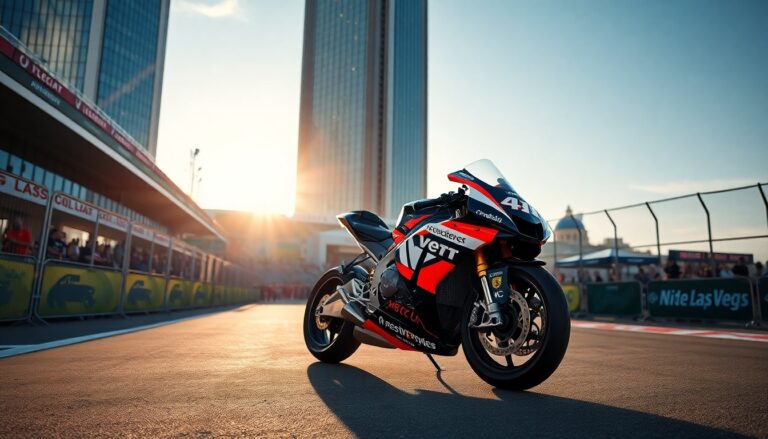Argomenti trattati
At the Formula 1 Grand Prix in Las Vegas, Carmelo Ezpeleta, a prominent figure in MotoGP, made a noteworthy statement that has ignited discussions among racing fans. He suggested the possibility of MotoGP incorporating street circuits into its racing calendar. This proposal could significantly alter the series and has led to lively debates within the motorsport community, revealing a mix of excitement and skepticism.
Understanding the context of street circuits
Street circuits have gained significant traction in motorsport, especially in Formula 1. Events such as the Monaco Grand Prix and the Azerbaijan Grand Prix attract large audiences, showcasing the excitement of high-speed racing against the backdrop of stunning cityscapes. Let’s tell the truth: the unique charm of these races enhances the overall experience for fans and drivers alike.
In this context, Dorna Sports CEO Carmelo Ezpeleta has proposed that MotoGP could adopt street circuits, contingent upon implementing specific safety measures. This idea reflects a growing trend in motorsport, where the allure of urban racing captivates fans and offers a fresh perspective on traditional circuits.
Ezpeleta’s vision for MotoGP
Let’s tell the truth: the future of MotoGP may be shifting towards urban tracks. During a recent discussion with reporters, Dorna Sports CEO Carmelo Ezpeleta shared his optimistic outlook on this potential development. He highlighted the importance of having adequate run-off areas to ensure rider safety, a fundamental concern in any racing event. Ezpeleta acknowledged the challenges presented by venues like Las Vegas, suggesting that existing Formula 1 circuits might be better suited for MotoGP. “We have no problem with racing on city circuits,” he affirmed, reiterating the sport’s commitment to safety since its establishment in 1992.
Moreover, Ezpeleta pointed out that the Mandalika circuit in Indonesia, although not a classic street circuit, possesses characteristics that could align with urban racing principles. His remarks suggest a strategic move to integrate MotoGP into urban racing, which could enhance the sport’s visibility and foster greater fan engagement. The emperor has no clothes, and I’m telling you: embracing urban tracks could redefine the landscape of motorcycle racing.
The potential thrill of street racing
Many motorsport enthusiasts find the prospect of MotoGP venturing into street racing exhilarating. The image of powerful motorcycles navigating through city streets and weaving around urban landscapes promises an electrifying atmosphere. Fans often compare this excitement to the Isle of Man TT, a legendary motorcycle race famed for its challenging terrain and stunning vistas. Although the TT is known for its inherent risks, it embodies the adventurous spirit that resonates with riders and fans alike.
Safety considerations in street racing
The appeal of street circuits in motorsport is undeniable, yet safety remains a critical concern. The dangers associated with motorcycle racing are significant, and high-profile incidents can result in serious injuries for riders. Carmelo Ezpeleta, a key figure in the sport, recognizes these risks and emphasizes the ongoing efforts to enhance safety measures. The real challenge lies in striking a balance between exhilarating racing and the necessary precautions to protect competitors.
As discussions regarding potential street races advance, it is crucial for MotoGP to address the logistical aspects involved. Leveraging existing Formula 1 circuits, which already implement established safety protocols, could ease the transition into urban racing. This collaboration between MotoGP and Formula 1 may not only facilitate a smoother adaptation to street racing but also attract new fans and sponsors in the process.
Exploring the future of MotoGP
The evolving landscape of motorsport suggests that MotoGP’s potential shift to street circuits could significantly change the series. Ezpeleta’s remarks indicate an openness to innovative formats and venues that appeal to today’s audiences. A proposed double-header event, featuring both MotoGP and Formula 1, could enhance the experience for fans, offering two exhilarating series in a single weekend.
The idea of MotoGP racing on city streets generates a mix of excitement and concern. Fans are keenly interested in how this concept will develop, with speculation regarding which cities might host future races. As the motorsport community observes closely, the potential for transformation presents an exhilarating opportunity for both riders and supporters.
While it may be premature to forecast the outcome of ongoing discussions, the notion of introducing street racing into MotoGP has certainly sparked dialogues that could influence the future of the sport. Ezpeleta’s vision appears poised to create new, exhilarating experiences for racing enthusiasts worldwide.

